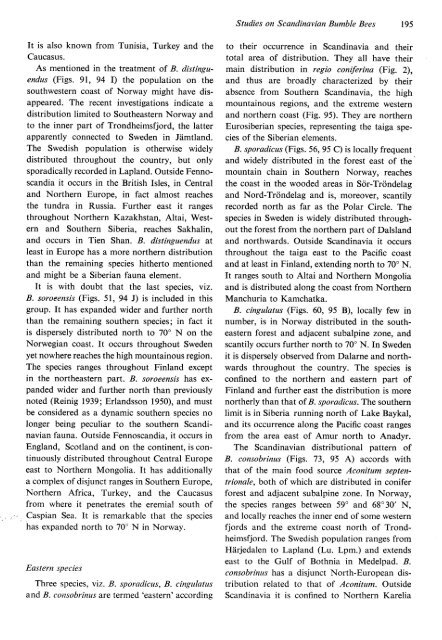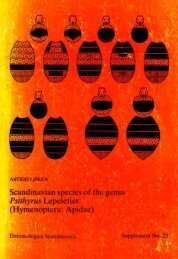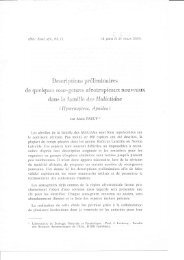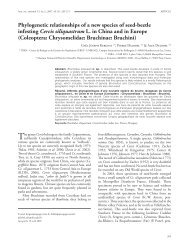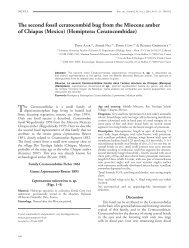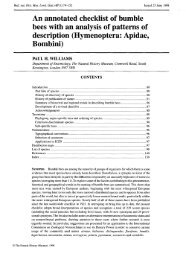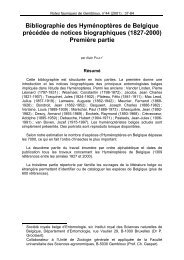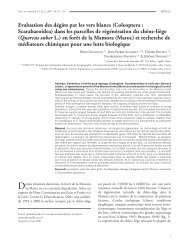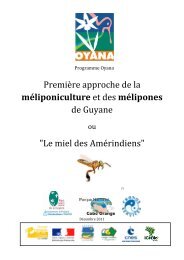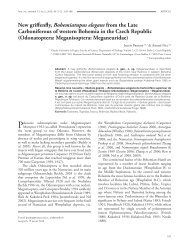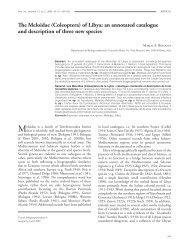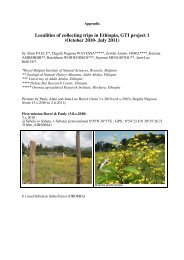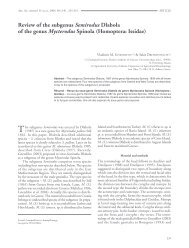Bumble Bees
Bumble Bees
Bumble Bees
You also want an ePaper? Increase the reach of your titles
YUMPU automatically turns print PDFs into web optimized ePapers that Google loves.
Studies on Scandinavian <strong>Bumble</strong> <strong>Bees</strong> 195It is also known from Tunisia, Turkey and theCaucasus.As mentioned in the treatment of B. distinguendus(Figs. 91, 94 I) the population on thesouthwestern coast of Norway might have disappeared.The recent investigations indicate adistribution limited to Southeastern Norway andto the inner part of Trondheirnsfiord, the latterapparently connected to Sweden in Jiimtland.The Swedish population is otherwise widelydistributed throughout the country, but onlysporadically recorded in Lapland. Outside Fennoscandiait occurs in the British Isles, in Centraland NorthernEurope, in fact almost reachesthe tundra in Russia. Further east it rangesthroughout Northern Kazakhstan, Altai, Westernand Southern Siberia, reaches Sakhalin,and occurs in Tien Shan. B. distinguendus atleast in Europe has a more northern distributionthan the remaining species hitherto mentionedand might be a Siberian fauna element.It is with doubt that the last species, viz.B. soroeensrs (Figs. 51, 94 J) is included in thisgroup. It has expanded wider and further norththan the remaining southern species; in fact itis dispersely distributed north to 70" N on theNorwegian coast. It occurs throughout Swedenyet nowhere reaches the high mountainous region.The species ranges throughout Finland exceptin the northeastern part. B. soroeensis has expandedwider and further north than previouslynoted (Reinig 1939; Erlandsson 1950), and mustbe considered as a dynamic southern species nolonger being peculiar to the southern Scandinavianfauna. Outside Fennoscandia, it occurs inEngland, Scotland and on the continent, is continuouslydistributed throughout Central Europeeast to Northern Mongolia. It has additionallya complex of disjunct ranges in Southern Europe,Northern Africa, Turkey, and the Caucasusfrom where it penetrates the eremial south ofCaspian Sea. It is remarkable that the specieshas expanded north to 70" N in Norway.Eastern speciesThree species, viz. B. sporadicus, B. cingulatusand B. consobrinus are termed 'eastern' accordingto their occurrence in Scandinavia and theirtotal area of distribution. They all have theirmain distribution in regio coniferina (Fig. 2),and thus are broadly characterized by theirabsence from Southern Scandinavia, the highmountainous regions, and the extreme westernand northern coast (Fig. 95). They are northernEurosiberian species, representing the taiga speciesof the Siberian elements.B. sporadicus (Figs. 56,95 C) is locally frequentand widely distributed in the forest east of themountain chain in Southern Norway, reachesthe coast in the wooded areas in Sor-Trcindelagand Nord-Trondelag and is, moreover, scantilyrecorded north as far as the Polar Circle. Thespecies in Sweden is widely distributed throughoutthe forest from the northern paft of Dalslandand northwards. Outside Scandinavia it occursthroughoutthe taiga east to the Pacific coastand at least in Finland, extending north to 70o N.It ranges south to Altai and Northern Mongoliaand is distributed along the coast from NorthernManchuria to Kamchatka.B. cingulatus (Figs. 60, 95 B), locally few innumber, is in Norway distributed in the southeasternforest and adjacent subalpine zone, andscantily occurs further north to 70" N. In Swedenit is dispersely observed from Dalarne and northwardsthroughout the country. The species isconfined to the northern and eastern part ofFinland and further east the distribution is morenortherly than that of ^8. sporadiczs. The southernlimit is in Siberia running north of Lake Baykal,and its occurrence along the Pacific coast rangesfrom the area east of Amur north to Anadyr.The Scandinavian distributional pattern ofB. consobrinus (Figs. 73, 95 A) accords withthat of the main food source Aconitum septentrionale,both of which are distributed in coniferforest and adjacent subalpine zone. In Norwoy,the species ranges between 59o and 68" 30' N,and locally reaches the inner end of some westernfiords and the extreme coast north of Trondheimsfiord.The Swedish population ranges fromHiirjedalen to Lapland (Lu. Lpm.) and extendseast to the Gulf of Bothnia in Medelpad. B.consobrinus has a disjunct North-European distributionrelated to that of Aconitum. OutsideScandinavia it is confined to Northern Karelia


